New Products & Services
February 2023
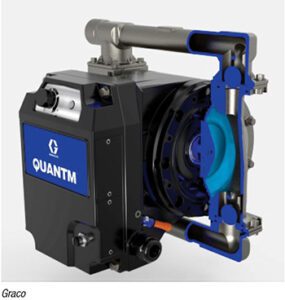 Quantm is a new electric-operated double diaphragm pump (photo) that features an advanced electric-motor design that is said to be significantly more efficient than a standard pneumatic pump. The pumps’ FluxCore motors and drives deliver up to eight times more continuous torque at low speeds than conventional motors, the company says. The pump offers a wide range of materials of construction to support multiple industrial and hygienic applications, including chemical processing, water treatment, paint manufacturing, pharmaceuticals and more. Designed to be a drop-in replacement for current pneumatic pumps or for greenfield construction, the pump is built for harsh industrial or hygienic environments, while also being lightweight and easy to maintain. — Graco Inc., Minneapolis, Minn.
Quantm is a new electric-operated double diaphragm pump (photo) that features an advanced electric-motor design that is said to be significantly more efficient than a standard pneumatic pump. The pumps’ FluxCore motors and drives deliver up to eight times more continuous torque at low speeds than conventional motors, the company says. The pump offers a wide range of materials of construction to support multiple industrial and hygienic applications, including chemical processing, water treatment, paint manufacturing, pharmaceuticals and more. Designed to be a drop-in replacement for current pneumatic pumps or for greenfield construction, the pump is built for harsh industrial or hygienic environments, while also being lightweight and easy to maintain. — Graco Inc., Minneapolis, Minn.
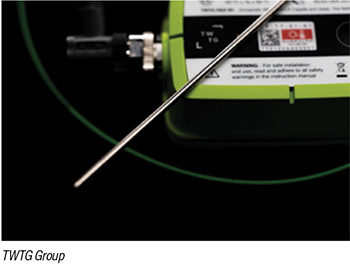 This company has recently received FCC, FM and IC certification for its NEON brand of temperature transmitters (photo) and vibration sensors. The NEON vibration sensor sends alerts to maintenance engineers as soon as assets, such as engines, conveyor belts and pumps, start to fail. This sets off a trigger when a change of amplitude is detected in the vibration spectrum or when outliers in the data occur. An engineer is alerted to check on this asset to prevent it from failure or long-term damage, which saves costs and ensures operational uptime. The NEON temperature transmitter is designed to be implemented quickly, and to transmit a signal for monitoring purposes via connection to an industrial thermocouple or RTD. The device can be connected to a thermocouple via an M12 connector with an up to 3-m-long extension cable. It uses on-board intelligence to determine average values over user-determined time scales to provide insights that can be used directly within existing systems. — TWTG Group B.V., Capelle a/d Ijssel, the Netherlands
This company has recently received FCC, FM and IC certification for its NEON brand of temperature transmitters (photo) and vibration sensors. The NEON vibration sensor sends alerts to maintenance engineers as soon as assets, such as engines, conveyor belts and pumps, start to fail. This sets off a trigger when a change of amplitude is detected in the vibration spectrum or when outliers in the data occur. An engineer is alerted to check on this asset to prevent it from failure or long-term damage, which saves costs and ensures operational uptime. The NEON temperature transmitter is designed to be implemented quickly, and to transmit a signal for monitoring purposes via connection to an industrial thermocouple or RTD. The device can be connected to a thermocouple via an M12 connector with an up to 3-m-long extension cable. It uses on-board intelligence to determine average values over user-determined time scales to provide insights that can be used directly within existing systems. — TWTG Group B.V., Capelle a/d Ijssel, the Netherlands
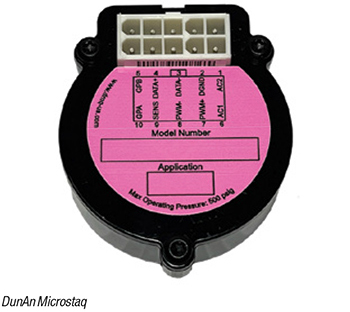 This company’s new digital pressure-temperature sensor (DPTS; photo) is designed to measure subcooling for HVAC-refrigeration applications. The DPTS is a self-contained device that measures pressure and temperature and calculates subcooling based on refrigerant type. It is compatible with safety-group A1, A2 and A2L refrigerants. The latest-generation DPTS can read maximum pressure between 500 and 700 psi. The DPTS is available as a superheat sensor as well. In a HVAC-R system, two DPTS sensors can be used to measure superheating and subcooling. Superheat measurements monitor the efficiency of the system and can be used as a safety sensor to protect the compressor from liquid flooding. Subcooling measurements monitor the refrigerant charge level and control the high-pressure flow-control valve to maintain the condenser mass flowrate. — DunAn Microstaq, Inc., Austin, Tex.
This company’s new digital pressure-temperature sensor (DPTS; photo) is designed to measure subcooling for HVAC-refrigeration applications. The DPTS is a self-contained device that measures pressure and temperature and calculates subcooling based on refrigerant type. It is compatible with safety-group A1, A2 and A2L refrigerants. The latest-generation DPTS can read maximum pressure between 500 and 700 psi. The DPTS is available as a superheat sensor as well. In a HVAC-R system, two DPTS sensors can be used to measure superheating and subcooling. Superheat measurements monitor the efficiency of the system and can be used as a safety sensor to protect the compressor from liquid flooding. Subcooling measurements monitor the refrigerant charge level and control the high-pressure flow-control valve to maintain the condenser mass flowrate. — DunAn Microstaq, Inc., Austin, Tex.
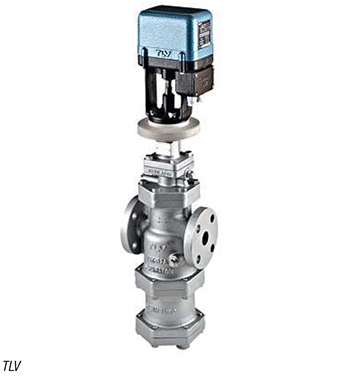 The MC-COS multi-control valve (photo) is a fully integrated device consisting of this company’s COS pressure-reducing valve, a separator, steam trap and a motorized actuator. It is designed for steam conditioning, as well as to control either the steam pressure or temperature of steam-heated processes. A major benefit of the MC-COS is its ability to instantaneously supply steam at the set pressure — when the pressure set value is changed, the new target can be achieved quickly and accurately. The system’s feedback-control configuration, as well as its servo-motor-driven actuator with proprietary algorithms, contributes to fast response and avoidance of overshooting and undershooting. The system is appropriate for automated processes requiring that supplied steam be at a stable pressure, and processes with frequent fluctuations in the pressure setting, including corrugation machinery, dryers, presses and jacketed equipment. — TLV Corp., Charlotte, N.C.
The MC-COS multi-control valve (photo) is a fully integrated device consisting of this company’s COS pressure-reducing valve, a separator, steam trap and a motorized actuator. It is designed for steam conditioning, as well as to control either the steam pressure or temperature of steam-heated processes. A major benefit of the MC-COS is its ability to instantaneously supply steam at the set pressure — when the pressure set value is changed, the new target can be achieved quickly and accurately. The system’s feedback-control configuration, as well as its servo-motor-driven actuator with proprietary algorithms, contributes to fast response and avoidance of overshooting and undershooting. The system is appropriate for automated processes requiring that supplied steam be at a stable pressure, and processes with frequent fluctuations in the pressure setting, including corrugation machinery, dryers, presses and jacketed equipment. — TLV Corp., Charlotte, N.C.
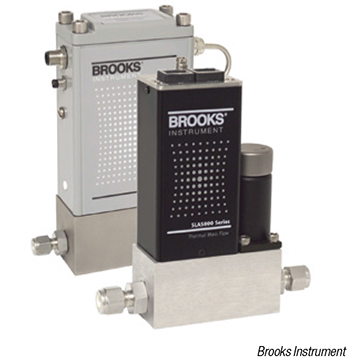 This company’s SLA Series mass-flow controllers (MFCs; photo) and meters now have new global certifications, including those covering the cure dates and shelf life of the elastomers used in the assembly and the surface roughness of the flow path, as well as special certification for users in Japan. MFC instruments precisely measure and control the delivery of gases to production systems and chambers, such as bioreactors. Certain regulatory and safety requirements call for certification and documentation of calibration protocols or other declarations about the materials of construction in the “wetted path” of the MFC, where the process gas flows through the device. Devices of the SLA series feature a high turndown ratio, an extremely low-leak-rate valve, an enhanced sensor design and pre-calibrated multigas pages for air, carbon dioxide, nitrogen and oxygen. The SLAMf Biotech offering is specifically designed for bioprocessing and other life-sciences applications to enhance gas-flow control range, enable process recipe flexibility and satisfy regulatory compliance requirements. — Brooks Instrument, Hatfield, Pa.
This company’s SLA Series mass-flow controllers (MFCs; photo) and meters now have new global certifications, including those covering the cure dates and shelf life of the elastomers used in the assembly and the surface roughness of the flow path, as well as special certification for users in Japan. MFC instruments precisely measure and control the delivery of gases to production systems and chambers, such as bioreactors. Certain regulatory and safety requirements call for certification and documentation of calibration protocols or other declarations about the materials of construction in the “wetted path” of the MFC, where the process gas flows through the device. Devices of the SLA series feature a high turndown ratio, an extremely low-leak-rate valve, an enhanced sensor design and pre-calibrated multigas pages for air, carbon dioxide, nitrogen and oxygen. The SLAMf Biotech offering is specifically designed for bioprocessing and other life-sciences applications to enhance gas-flow control range, enable process recipe flexibility and satisfy regulatory compliance requirements. — Brooks Instrument, Hatfield, Pa.
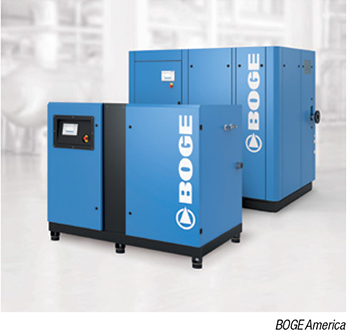 The S-4 Series of screw compressors now includes options for the 45- to 75-kW performance range (photo). All models are characterized by quiet, reliable operation and have high efficiency. The compressors generate high free-air delivery at low specific-power consumption. The energy use of the new 75-kW compressor has been reduced by over 12% compared with its predecessor, while the free-air delivery has increased by almost 9%, according to the manufacturer. The new compressors come standard with low-energy IE4 motors and permanent-magnet motors. The compressors’ vertical-oil separation concept ensures very low residual-oil content, minimal pressure losses and a long service life. The internal cartridge is easy to remove and replace. Maintenance takes place from two sides with just a few simple movements — the intake filter is accessible and both the oil and air coolers can easily be removed and cleaned. Furthermore, the company says it was able to reduce the noise in the 45-kW performance class by more than 8 dB(A). — BOGE America, Inc., Powder Springs, Ga.
The S-4 Series of screw compressors now includes options for the 45- to 75-kW performance range (photo). All models are characterized by quiet, reliable operation and have high efficiency. The compressors generate high free-air delivery at low specific-power consumption. The energy use of the new 75-kW compressor has been reduced by over 12% compared with its predecessor, while the free-air delivery has increased by almost 9%, according to the manufacturer. The new compressors come standard with low-energy IE4 motors and permanent-magnet motors. The compressors’ vertical-oil separation concept ensures very low residual-oil content, minimal pressure losses and a long service life. The internal cartridge is easy to remove and replace. Maintenance takes place from two sides with just a few simple movements — the intake filter is accessible and both the oil and air coolers can easily be removed and cleaned. Furthermore, the company says it was able to reduce the noise in the 45-kW performance class by more than 8 dB(A). — BOGE America, Inc., Powder Springs, Ga.
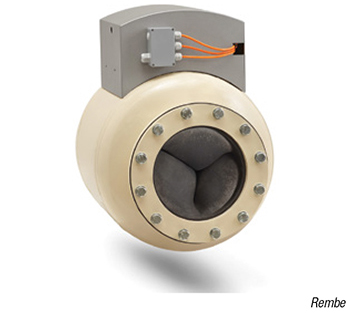 Process equipment is usually connected by pipelines through which, if an explosion occurs, fire and pressure can spread very rapidly. Propagating explosions pose increased risks of secondary explosions. The intensity of the explosion in connected vessels is increased by pressure piling and flame jet ignition. In the event of an explosion detection by either infrared optical sensor or pressure-switch signals, the new EXKOP Express controller activates the connected explosion-isolation systems, such as this company’s QV II or QV III quench valve (photo). Depending on the needs of a particular process, the EXKOP Express can also be used to activate the Q-Bic chemical-extinguishing barrier in one or multiple pipes. The Q-Bic system can protect large-diameter pipes, and the hygienic interface is compatible with sanitary food-processing installations. — Rembe, Inc., Fort Mill, S.C.
Process equipment is usually connected by pipelines through which, if an explosion occurs, fire and pressure can spread very rapidly. Propagating explosions pose increased risks of secondary explosions. The intensity of the explosion in connected vessels is increased by pressure piling and flame jet ignition. In the event of an explosion detection by either infrared optical sensor or pressure-switch signals, the new EXKOP Express controller activates the connected explosion-isolation systems, such as this company’s QV II or QV III quench valve (photo). Depending on the needs of a particular process, the EXKOP Express can also be used to activate the Q-Bic chemical-extinguishing barrier in one or multiple pipes. The Q-Bic system can protect large-diameter pipes, and the hygienic interface is compatible with sanitary food-processing installations. — Rembe, Inc., Fort Mill, S.C.